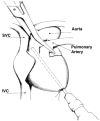Targeting calcium cycling proteins in heart failure through gene transfer
- PMID: 12509478
- PMCID: PMC2342481
- DOI: 10.1113/jphysiol.2002.026732
Targeting calcium cycling proteins in heart failure through gene transfer
Abstract
Our understanding of cardiac excitation-contraction coupling has improved significantly over the last 10 years. Furthermore, defects in the various steps of excitation-contraction coupling that characterize cardiac dysfunction have been identified in human and experimental models of heart failure. The various abnormalities in ionic channels, transporters, kinases and various signalling pathways collectively contribute to the 'failing phenotype.' However, deciphering the causative changes continues to be a challenge. An important tool in dissecting the importance of the various changes in heart failure has been the use of cardiac gene transfer. To achieve effective cardiac gene transfer a number of obstacles remain, including appropriate vectors for gene delivery, appropriate delivery systems, and a better understanding of the biology of the disease. In this review, we will examine our current understanding of these various factors. Gene transfer provides not only a potential therapeutic modality but also an approach to identifying and validating molecular targets.
Figures





Similar articles
-
Cardiac adenoviral S100A1 gene delivery rescues failing myocardium.J Clin Invest. 2004 Dec;114(11):1550-63. doi: 10.1172/JCI21454. J Clin Invest. 2004. PMID: 15578088 Free PMC article.
-
Na(+)-Ca(2+) exchange in failing myocardium: friend or foe?Circ Res. 2000 Sep 29;87(7):529-31. doi: 10.1161/01.res.87.7.529. Circ Res. 2000. PMID: 11009553 No abstract available.
-
Sarcoplasmic reticulum Ca2+ and heart failure: roles of diastolic leak and Ca2+ transport.Circ Res. 2003 Sep 19;93(6):487-90. doi: 10.1161/01.RES.0000091871.54907.6B. Circ Res. 2003. PMID: 14500331 No abstract available.
-
Manipulating cardiac contractility in heart failure: data from mice and men.Circulation. 2004 Jan 20;109(2):150-8. doi: 10.1161/01.CIR.0000111581.15521.F5. Circulation. 2004. PMID: 14734503 Review. No abstract available.
-
[Function and role of the sarcoplasmic reticulum in heart disease].Arch Cardiol Mex. 2006 Oct-Dec;76 Suppl 4:S18-32. Arch Cardiol Mex. 2006. PMID: 17469332 Review. Spanish.
Cited by
-
Heart failure: a model of cardiac and skeletal muscle energetic failure.Pflugers Arch. 2006 Sep;452(6):653-66. doi: 10.1007/s00424-006-0072-7. Epub 2006 Jun 10. Pflugers Arch. 2006. PMID: 16767467 Review.
-
Antenatal Glucocorticoid Administration Promotes Cardiac Structure and Energy Metabolism Maturation in Preterm Fetuses.Int J Mol Sci. 2022 Sep 5;23(17):10186. doi: 10.3390/ijms231710186. Int J Mol Sci. 2022. PMID: 36077580 Free PMC article. Review.
-
Concomitant intravenous nitroglycerin with intracoronary delivery of AAV1.SERCA2a enhances gene transfer in porcine hearts.Mol Ther. 2012 Mar;20(3):565-71. doi: 10.1038/mt.2011.268. Epub 2012 Jan 3. Mol Ther. 2012. PMID: 22215018 Free PMC article.
-
Targeted SERCA2a gene expression identifies molecular mechanism and therapeutic target for arrhythmogenic cardiac alternans.Circ Arrhythm Electrophysiol. 2009 Dec;2(6):686-94. doi: 10.1161/CIRCEP.109.863118. Circ Arrhythm Electrophysiol. 2009. PMID: 19948504 Free PMC article.
-
Regulation of phosphodiesterase 3 and inducible cAMP early repressor in the heart.Circ Res. 2007 Mar 2;100(4):489-501. doi: 10.1161/01.RES.0000258451.44949.d7. Circ Res. 2007. PMID: 17332439 Free PMC article. Review.
References
-
- Arai M, Matsui H, Periasamy M. Sarcoplasmic reticulum gene expression in cardiac hypertrophy and heart failure. Circ Res. 1994;74:555–564. - PubMed
-
- Askari AT, Penn MS. Targeted gene therapy for the treatment of cardiac dysfunction. Semin Thorac Cardiovasc Surg. 2002;14:167–177. - PubMed
-
- Bers DM. Calcium and cardiac rhythms: physiological and pathophysiological. Circ Res. 2002a;90:14–17. - PubMed
-
- Bers DM. Cardiac excitation-contraction coupling. Nature. 2002b;415:198–205. - PubMed
Publication types
MeSH terms
Substances
Grants and funding
LinkOut - more resources
Full Text Sources
Other Literature Sources
Medical

